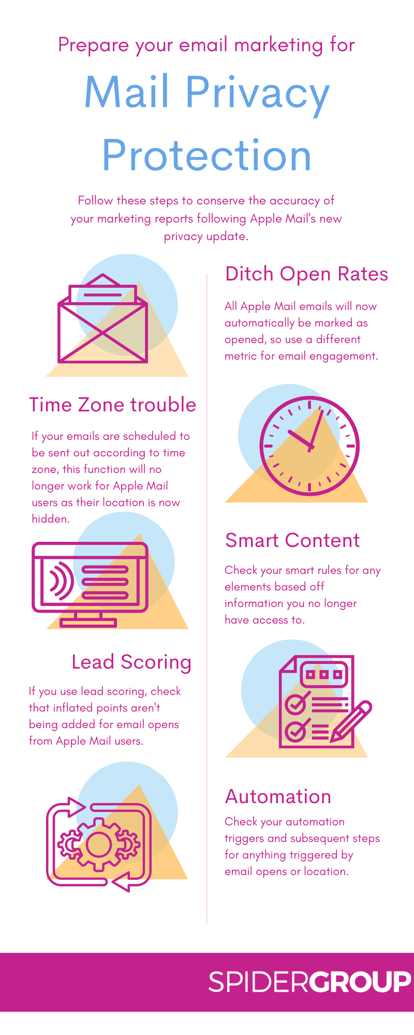You've probably heard about the Apple Mail iOS changes. As of the 20th September 2021, Apple Mail has implemented “Mail Privacy Protection”, which hides certain information from email providers.
You may be wondering what that means for your email marketing strategy, so let’s take a look at what has been affected by the change and what you can do about it.
What is the Update?
Ultimately, Apple are trying to make it easier for users to hide their online activity and increase their privacy. This may be frustrating for marketers but it is, overall, a positive move for consumers.
Previously, email providers such as MailChimp and HubSpot were able to supply marketers with a variety of location and activity-based information about email recipients using most popular email clients. Now, Apple Mail will hide user’s location, IP addresses, and whether or not they have opened an email.
.png?width=676&name=Untitled%20design%20(54).png)
You might think that this will mean you’re likely to see your email “open” figures drastically reduce but, in fact, it’s the opposite. Apple Mail are hiding this data by automatically loading the pixel that is usually only triggered on emails that have been opened, so you may see that any emails sent to Apple Mail users have a 100% open rate.
While this may look exciting when you first glance at your email figures, it’s an artificially inflated metric which is bad news for the accuracy of your reporting.
Do Open Rates Matter?
In truth, open rates have never been completely accurate. On Outlook, for example, the pixel that measures open rates might not be activated unless the recipient clicks the “download images” message.
However, many businesses have been using it as a key engagement metric and, if you’re one of them, this new update may serve as a wake-up call to step away now. As the update rolls out and your open rates soar, this metric will become an increasingly inaccurate way to measure email engagement.
.png?width=674&name=Untitled%20design%20(55).png)
You may be able to reduce the damage to your reports if your email provider allows you to filter out those using certain email clients but, now Apple has started to pay more attention to mail privacy, it is possible that other providers will begin to follow the trend. Because of this, it may be a good idea to make the move to measuring engagement differently at this point rather than when it’s affecting your accuracy in a more significant way.
What else will be Affected? 
Many providers used for sending marketing emails allow you to schedule emails to go out at different times, according to the recipient’s time zone. For instance, you may want to send out an email to arrive at 9am local time, wherever in the world your contacts are.
Now that the update is hiding their locations, this feature will become obsolete for Apple Mail users (although, for now, other recipients should be unaffected). This might be something you need to strategise about if your company has a geographically diverse contact list.
For similar reasons, any smart content in your emails that is dependent on location rather than a property on your CRM will need to be re-evaluated.
Lead Scoring
Lead Scoring (assigning prospects points according to their activity or information) can be a powerful way to prioritise and nurture your most promising leads. However, if this is a strategy your business uses, you will need to check your parameters to work with the new privacy restrictions.
Find out if points are currently assigned to leads for opening emails and, if so, switch this to an alternate engagement metric or remove it entirely. Without making this change, it is likely that Apple Mail users  will be given higher points than their engagement actually indicates.
will be given higher points than their engagement actually indicates.
What does it mean for Automation?
We’ve already mentioned that you will need to check your smart content. In addition, you may want to spend some time going through your automatic processes as a whole. Keep any eye out for any triggers, workflows or sequences that are based on information or activity that is now hidden on Apple Mail.
A common example of this is if you have an automation that sends someone a follow-up if they have opened an email but not carried out the action it contains. Without amendment, this may be sent out to people who didn’t even notice the first email, affecting the quality of your communication. Your processes will feel much less human and trustworthy if clients receive an email starting with “I noticed you opened this email…” when they didn’t do anything of the kind.
For this reason, you may need to find other triggers to build the functionality that you want with your automation. You could, for example, look into using emails received by prospects or links clicked within emails. If you do this, make sure to check any messages sent to clients in subsequent steps to ensure that they still make sense.
What can you do about it?
So, what can you do about the changes? Other than checking everything that might be affected in your marketing system… not much. Ultimately, this is something happening outside your control that may well increase in scope as other members of the industry join in.
.png?width=672&name=20%20(1).png)
Something you can and should focus on is creating the best possible experience for your email recipients. Open rates have never been 100% accurate anyway and your ultimate goal should be getting people to engage with your content, rather than focusing on the passive engagement of an “open”.
This means measuring the people who don’t only open an email but take action that shows a deeper interest in it – for example clicking a link, watching a video, or sending a reply.
By measuring your email success through active engagement, you can focus on optimising your emails for the types of interaction that build a deeper relationship with your customers and prospects. Focus on those more valuable milestones on the buyer’s journey by putting more weight on metrics such as click-through rates and conversions rather than open rates.
It will always be frustrating knowing that some of the data showing up on your reports is inflated, so concentrating instead on data you can rely on gives you something accurate to work with and can change the focus to the metrics which have always mattered more to your bottom line.

.png)
